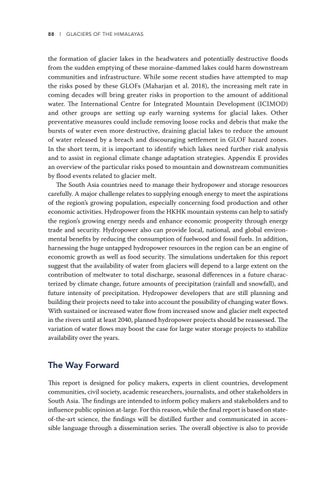88 l Glaciers of the Himalayas
the formation of glacier lakes in the headwaters and potentially destructive floods from the sudden emptying of these moraine-dammed lakes could harm downstream communities and infrastructure. While some recent studies have attempted to map the risks posed by these GLOFs (Maharjan et al. 2018), the increasing melt rate in coming decades will bring greater risks in proportion to the amount of additional water. The International Centre for Integrated Mountain Development (ICIMOD) and other groups are setting up early warning systems for glacial lakes. Other preventative measures could include removing loose rocks and debris that make the bursts of water even more destructive, draining glacial lakes to reduce the amount of water released by a breach and discouraging settlement in GLOF hazard zones. In the short term, it is important to identify which lakes need further risk analysis and to assist in regional climate change adaptation strategies. Appendix E provides an overview of the particular risks posed to mountain and downstream communities by flood events related to glacier melt. The South Asia countries need to manage their hydropower and storage resources carefully. A major challenge relates to supplying enough energy to meet the aspirations of the region’s growing population, especially concerning food production and other economic activities. Hydropower from the HKHK mountain systems can help to satisfy the region’s growing energy needs and enhance economic prosperity through energy trade and security. Hydropower also can provide local, national, and global environmental benefits by reducing the consumption of fuelwood and fossil fuels. In addition, harnessing the huge untapped hydropower resources in the region can be an engine of economic growth as well as food security. The simulations undertaken for this report suggest that the availability of water from glaciers will depend to a large extent on the contribution of meltwater to total discharge, seasonal differences in a future characterized by climate change, future amounts of precipitation (rainfall and snowfall), and future intensity of precipitation. Hydropower developers that are still planning and building their projects need to take into account the possibility of changing water flows. With sustained or increased water flow from increased snow and glacier melt expected in the rivers until at least 2040, planned hydropower projects should be reassessed. The variation of water flows may boost the case for large water storage projects to stabilize availability over the years.
The Way Forward This report is designed for policy makers, experts in client countries, development communities, civil society, academic researchers, journalists, and other stakeholders in South Asia. The findings are intended to inform policy makers and stakeholders and to influence public opinion at-large. For this reason, while the final report is based on stateof-the-art science, the findings will be distilled further and communicated in accessible language through a dissemination series. The overall objective is also to provide




